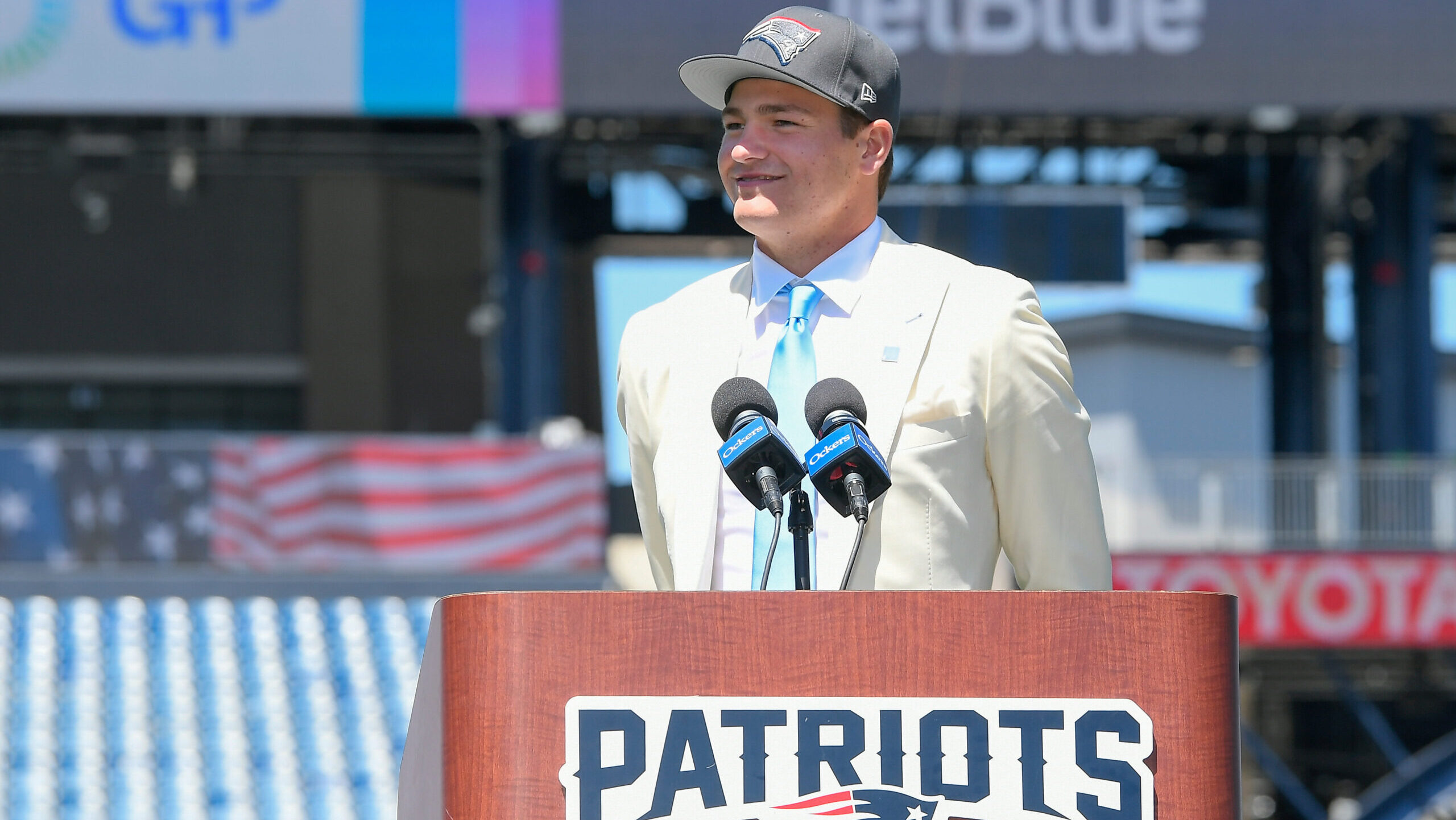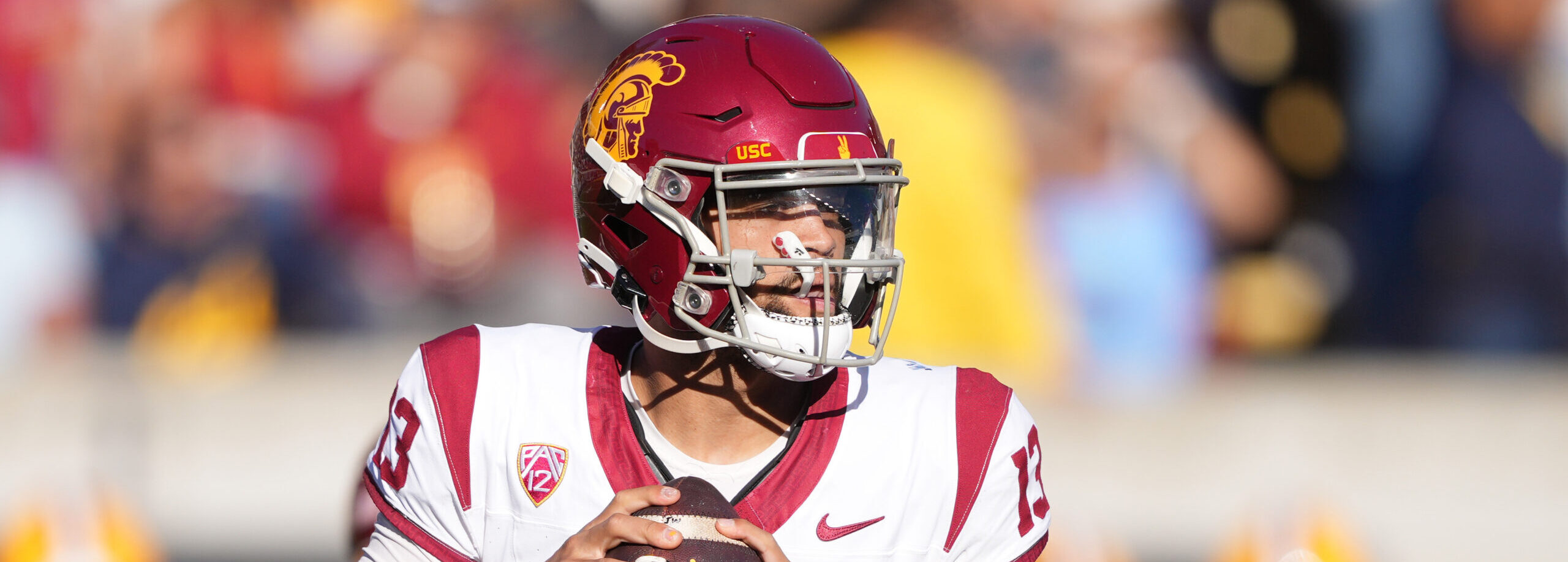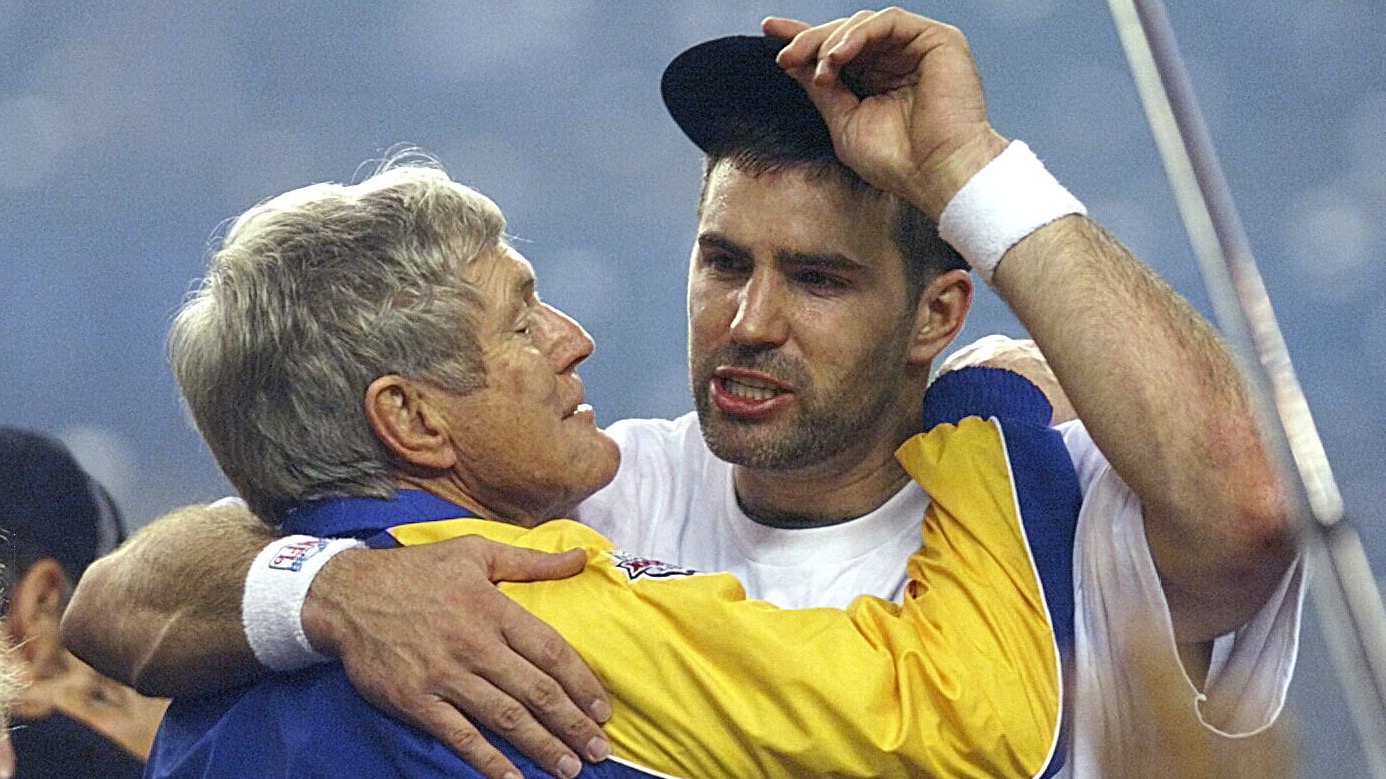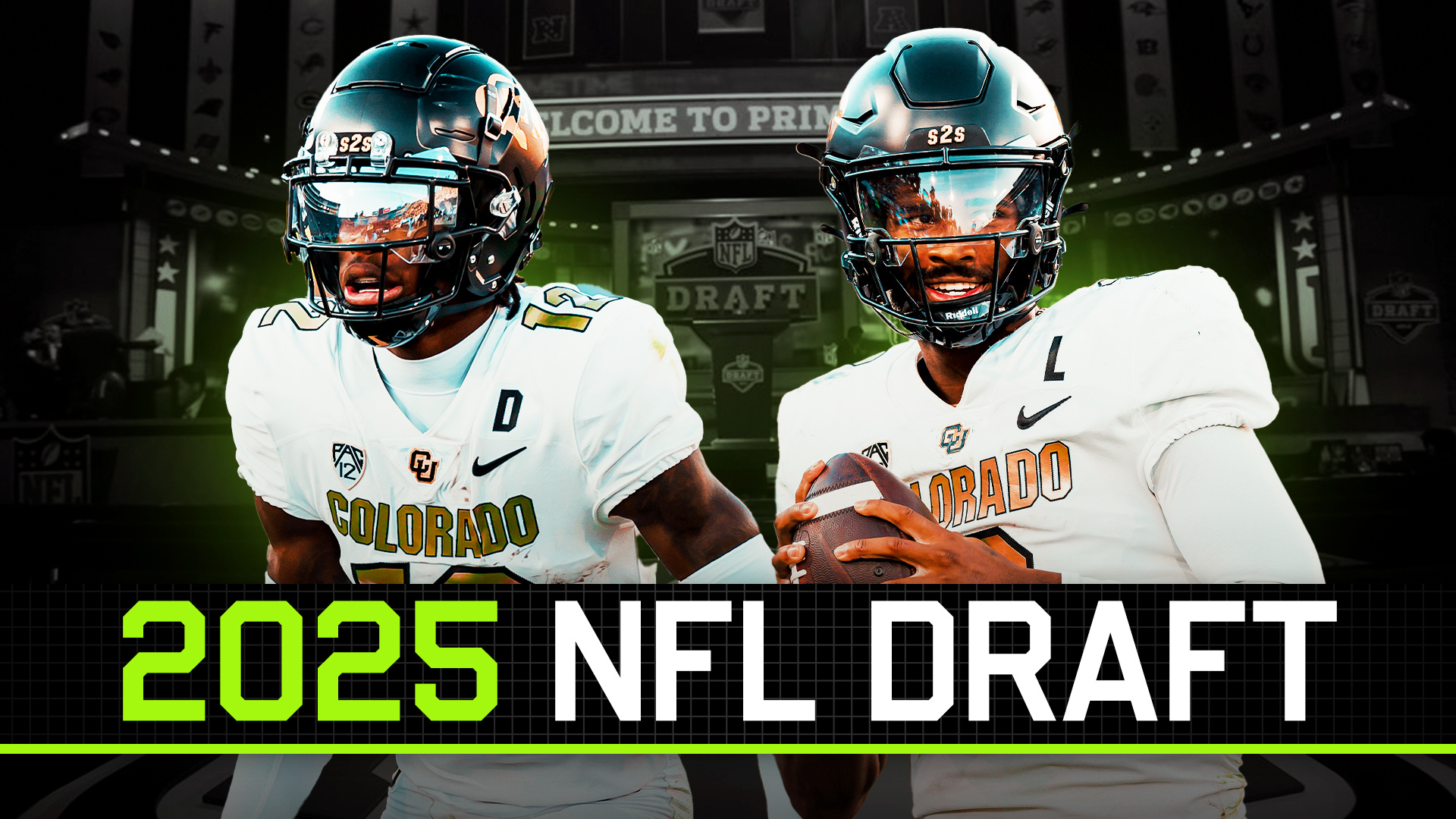Expert Analysis
2/8/24
27 min read
Super Bowl LVIII Preview: What To Watch When Each Team Has The Ball
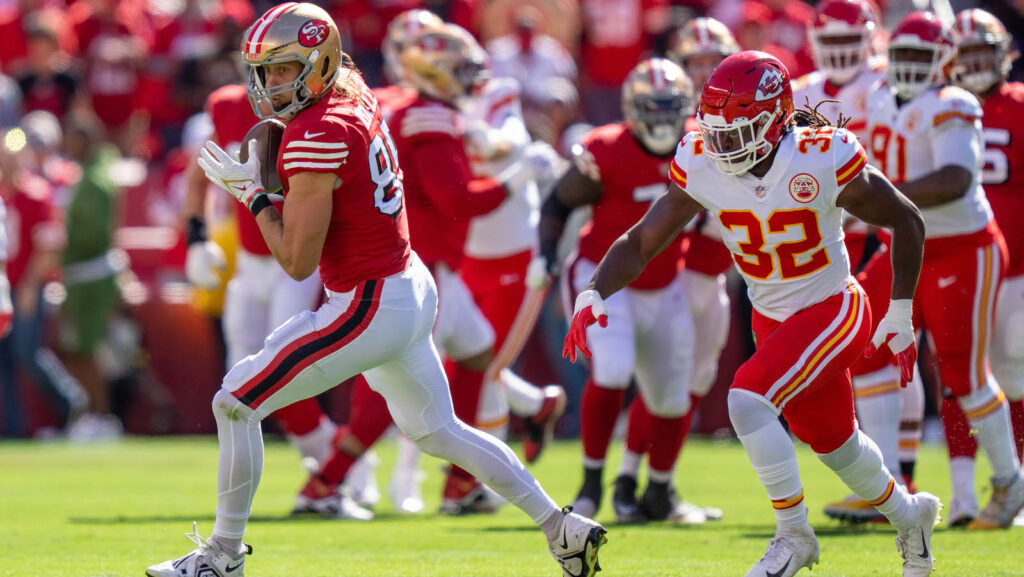
It’s been a long road, but we’re here: Super Bowl 58. Las Vegas. Kansas City Chiefs. San Francisco 49ers.
The Chiefs are back after an up-and-down season with some panic along the way. Unlike past trips, Kansas City has a defense that ranks fifth in EPA per play and has bailed out the offense on occasion. But heading into the Super Bowl, that offense with Patrick Mahomes looks like it’s taking shape again.
They’ll face the 49ers, who have ridden a nearly unstoppable offense through the league. The Niners' offense finished first in nearly every imaginable metric while the defense has been opportunistic throughout the season.
We will look at several aspects of this game when each team has the ball.
All data is from TruMedia unless noted otherwise.
 When The 49ers Have The Ball
When The 49ers Have The Ball
Can The 49ers Start Fast?
There’s a good reason we’re starting with one of the biggest cliches in football. During the regular season, no team started better than the 49ers. Per TruMedia, 58.8 percent of San Francisco’s opening drives resulted in a touchdown. The next best team was the Baltimore Ravens at 41.2 percent. The league average was 22.6 percent.
This wasn’t just impressive for the 2023 season, it was the highest rate of opening-drive touchdowns in a regular season since at least 2000.
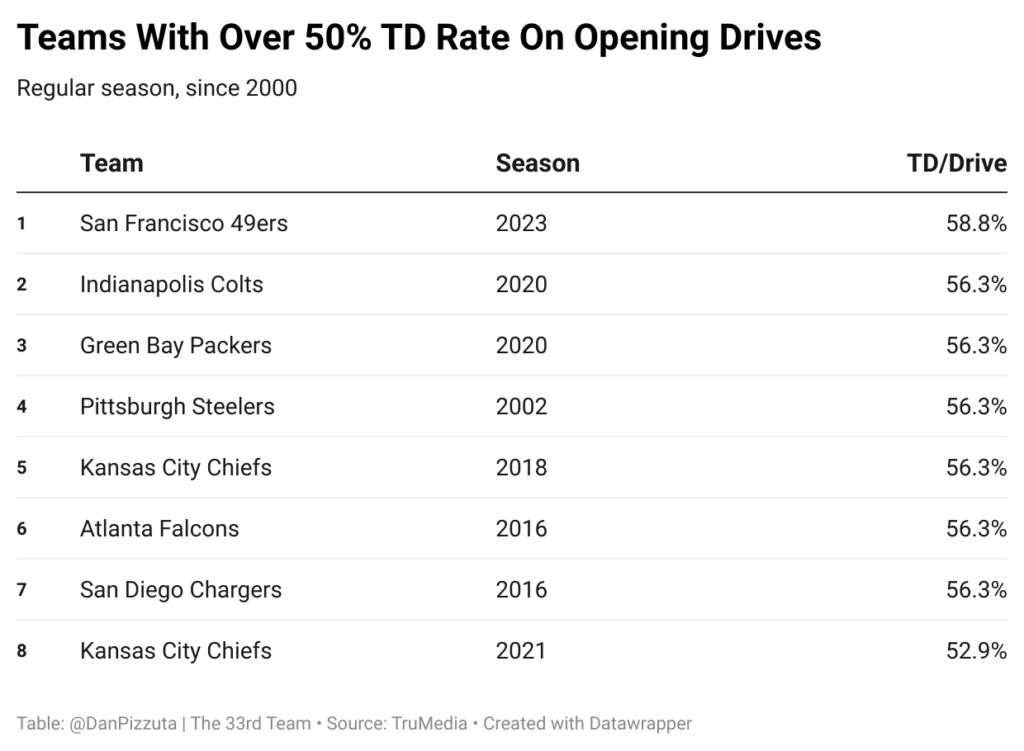
They were the only team to average more than 4.0 points per drive and 2.0 EPA per drive on opening possessions. Those drives encapsulated everything about the Kyle Shanahan play-calling experience. The 49ers have a unique set of personnel groupings, using 21 on a league-leading 59.7 percent of plays, and mixing the run and the pass with a 53.8 percent pass rate, which was the second-lowest in the league on opening drives.
The 49ers didn’t necessarily establish the run, they were out there throwing haymakers from the start. Christian McCaffrey had 331 rushing yards and a 69.2 percent success rate on opening drive carries. 23.1 percent of McCaffrey’s runs gained 10 or more yards and just 2.8 percent were stopped at or behind the line of scrimmage.
San Francisco used the heavier personnel groupings and motion from those looks to create open rushing lanes, even while defenses were ready for it. Only 2.6 percent of McCaffrey’s opening drive rushes came against a light box but 46.2 percent came against a stacked box.
The 49ers often used those defensive boxes to their favor, which opened holes and left little resistance in the second level once McCaffrey got there. Here is McCaffrey ripping a 72-yard run against a five-man front from the Seattle Seahawks.
Christian McCaffrey 72-yard opening drive run pic.twitter.com/HebT5Tzfud
— Dan Pizzuta (@DanPizzuta) February 6, 2024
But this hasn’t been the case so far in the playoffs. San Francisco has not scored on either of its opening possessions, and the 49ers have averaged -0.09 EPA per play. The biggest difference is there isn't as much room to work in the run game.
Defenses haven’t committed more to the run — in fact, McCaffrey has run into fewer stacked boxes — but linebackers are playing with more discipline. In the playoffs, McCaffrey has averaged just 0.5 yards before contact per rush with a 16.7 percent success rate.
Lions did not give the 49ers room to run early in the NFCCG pic.twitter.com/PGtAVZSICJ
— Dan Pizzuta (@DanPizzuta) February 6, 2024
The same swing has impacted Brock Purdy. On opening drives in the regular season, Purdy averaged 0.65 EPA per play and 8.8 yards per attempt with a 63.3 percent success rate. That has dropped to -0.14 EPA per play and 6.1 yards per attempt with a 40 percent success rate in the playoffs.
During the regular season and playoffs, the Chiefs have allowed a touchdown on 15 percent of opponents’ opening drives. That rate ranks ninth-best. The 1.35 points per drive allowed is the sixth-best mark. In the playoffs, the Chiefs forced two punts and a field goal.
How Does Brock Purdy Handle Pressure?
Overall, Purdy was one of the better quarterbacks against pressure during the 2023 season, ranking sixth in EPA per play and third in success rate. Of course, even the best quarterbacks perform significantly worse against pressure than when kept clean. That third-best success rate was only 38 percent.
While Purdy can handle pressure, some of his worst games were when he was pressured most often. In Week 6 against the Cleveland Browns, Purdy was pressured on half of his dropbacks. He completed 44.4 percent of his passes and averaged 4.1 yards per attempt. In Week 16 against the Ravens, Purdy was pressured on 44.1 percent of his dropbacks and had a 37.1 percent success rate.
The constant pressure can rush Purdy’s process and force him to flee the pocket. His ability to create and extend plays out of structure has separated him from previous Shanahan quarterbacks like Jimmy Garoppolo, but Purdy can't live outside of structure.
This also plays out against the blitz. Purdy was third in EPA per play and first in success rate against the blitz in the regular season. When an extra defender comes, Purdy is quick and smart enough to find gaps in coverage. But when the pressure gets home, that’s where Purdy can struggle. Including the playoffs, Purdy has been pressured on 44 percent of blitzes against him.

This also matters when the defense blitzes a defensive back. Purdy was seventh in EPA per play and first in success rate, but he was pressured on 47.1 percent of those snaps, including the playoffs.
Against the Lions, Detroit sent a defensive back nine times. Purdy was only pressured on three of those dropbacks, but he averaged -0.16 EPA per play and 4.0 yards per attempt. It was his worst game against these kinds of looks and facing a defense that was more bust than boom on those plays during the regular season.
The key is whether the rush is enough to get Purdy out of the pocket. On those plays with at least one defensive back as a pass rusher, no quarterback had a higher rate of plays finished outside the pocket (30 percent). When outside the pocket on those plays, Purdy averaged -0.28 EPA per play and had a 38 percent success rate.
Only the Minnesota Vikings sent a defensive back as a pass rusher more often than the Chiefs but no team was better. Kansas City allowed a league-low 3.1 yards per play with pressure on 47.2 percent of those plays. The Chiefs can mix up the looks by having a defensive back as part of a blitz or as a sim pressure on a four-man rush. Either way, Kansas City can create a free rusher or a blocking mismatch.
Through the playoffs, the Chiefs have allowed 3.1 yards per play with a 47.2% pressure rate when they send at least one DB as part of the pass rush. pic.twitter.com/s5S5SypEOj
— Dan Pizzuta (@DanPizzuta) February 7, 2024
Trent McDuffie has 17 pressures, and Justin Reid has 11, which ranks third and ninth among defensive backs.
The 49ers use the most condensed formations on average, which brings defensive backs closer to the formation and gives them a shorter route to the quarterback if they rush the passer.
Of course, the Chiefs also have players like Chris Jones, who can take over in the pass rush if necessary.
Will The Middle of The Field Be Open?
The rise of two high defenses stemmed from defenses trying to stop the Chiefs' offense, but no defense leans more into the use of middle-of-the-field open coverages than the Chiefs’.
Kansas City uses two-high coverages on two-thirds of its defensive snaps. Only the Arizona Cardinals were also over 60 percent this season. This isn’t just a static Cover-2. The Chiefs, under defensive coordinator Steve Spagnuolo, will present various pre-snap looks that will rotate into something different after the snap.
Even when the rotation doesn’t really impact the play, it can confuse a quarterback just enough to hold the ball and panic — as it did on the first quarter interception of Tua Tagovailoa in the wild-card round.
Chiefs show single-high before spinning to two-high at the snap. Tua gets to the right place to throw the ball, just sails his throw. pic.twitter.com/AhBcozrnbx
— Bill Barnwell (@billbarnwell) January 14, 2024
The Chiefs will also play aggressively at the line of scrimmage and have the sixth-highest rate of man coverage when the defense plays with the middle of the field open. This is also where Kansas City can get creative with its blitz looks.
Only the Giants, Vikings, Patriots and Buccaneers had a higher blitz rate from two-high coverages. That gives Kansas City the ability to concentrate pass rushers up the middle and still have the width of the field covered in the back end.
Having that safety help can also allow the Chiefs’ cornerbacks to be more aggressive when breaking on the ball. L’Jarius Sneed has 10 passes defended when Kansas City has two safeties deep.
It might not be a surprise that with how heavy the 49ers typically are in their offensive personnel, they don’t see two-high coverages often. Only Justin Herbert had a lower percentage of dropbacks with the middle of the field open than Purdy, 38.5 percent of the time.
The 49ers were successful no matter the coverage but the post-snap safety alignment had an impact on where Purdy threw. Against single-high, 27.4 percent of Purdy’s throws went to the intermediate area of the field (11-19 air yards). Against two-high, that dropped to 21 percent, but his rate of short passes went from 41.3 percent against single-high to 50.2 percent against two-high.
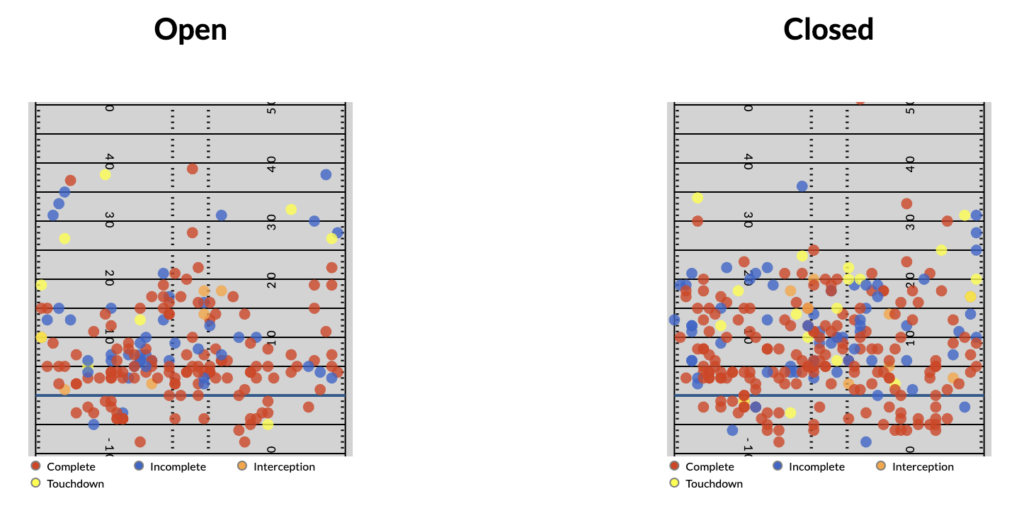
San Francisco thrived in the intermediate area all season, so it could benefit Kansas City to take those throws away. Overall, Purdy had a league-high 24.1 percent of pass attempts between 11-19 air yards.
He was just 12th in EPA per play on those throws and had a 5.3 percent interception rate but the volume of passes to that area led to more good than bad. It’s clearly the go-to area for San Francisco's top three receivers.

When the Chiefs played two-high, they allowed a league-low 6.2 yards per play on intermediate passes. But if Kansas City is going to encourage shorter passes, especially up the middle, the Chiefs have to sure up their defense in that area. On throws from 1-10 air yards between the numbers, Kansas City is 23rd in EPA per play and 25th in yards per play.
Matching San Francisco's Personnel
There might not be a more fascinating chess match than how these two teams match personnel when the 49ers have the ball. San Francisco has used 21 personnel on 36.5 percent of snaps this season. What makes the 49ers’ use of 21 so dangerous is it could look like anything on a given play.
Traditional I-formation? Sure. Split back in the shotgun? That too. 2x2? Yup. Empty? You bet. Here are images at the time of the snap of four consecutive plays against the Lions in the NFC Championship Game.
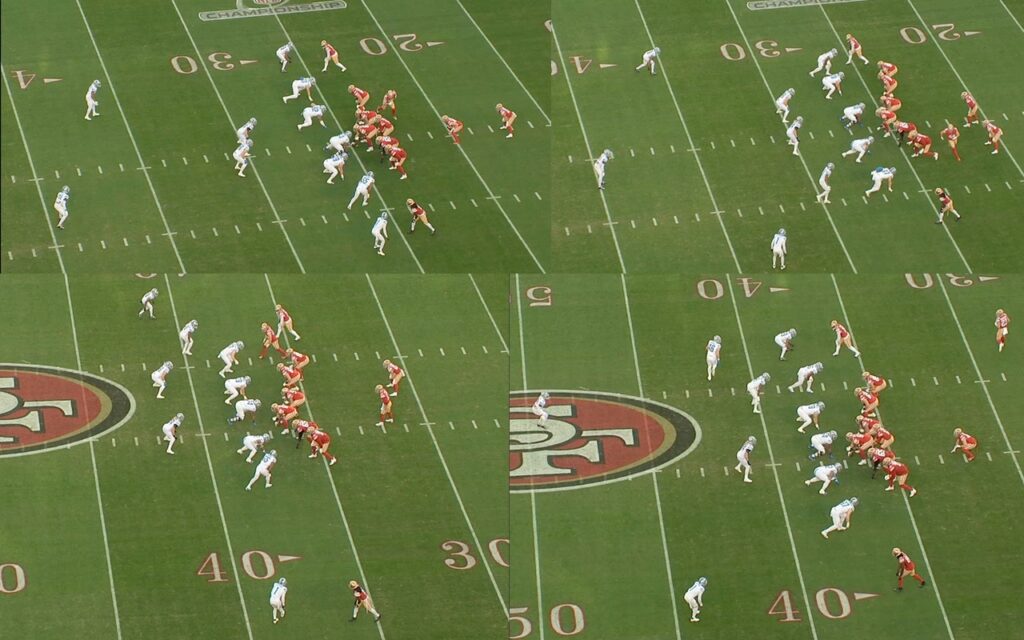
The 49ers also have higher-than-average rates in 12 and 22 personnel. Only the Atlanta Falcons ran a lower percentage of plays in 11 personnel than San Francisco. The heavier personnel packages do not stop the 49ers from being versatile, explosive and dynamic, which is not the case for the typical heavy package.
That’s especially true when this team gets in empty. Purdy has averaged 0.26 EPA per play and 10.5 yards per attempt from empty in 2023. 25 percent of the 49ers’ empty snaps have come from 21, which is second in the league to the Dolphins.
Purdy technically has a negative EPA from empty in 21 but that almost entirely stems from the poor outing against the Ravens when he threw two interceptions from the formation. Take out Week 16 and Purdy averages 0.38 EPA per play and 13.3 yards per attempt.
It’s not just that anyone can line up anywhere — and the 49ers will do that with McCaffrey, Deebo Samuel and Kyle Juszczyk — but it’s that anyone can get the ball and become an instant threat. From 21 personnel, 51.6 percent of Purdy’s passes go to wide receivers, 31.9 percent go to running backs and 14.4 percent go to tight ends. That’s a massive range.
And since this is a Shanahan team we’re talking about, there’s no problem running the ball from these packages.S
Where does that leave the Chiefs? Kansas City is a defensive back-focused defense and has leaned into that more in the playoffs — as Spags has done previously in the postseason with the Chiefs.
In the regular season, the Chiefs had the fourth-highest rate of plays in dime personnel (six defensive backs) at 22.1 percent. That has increased to 32.5 percent in the playoffs. Even against a run-heavy team in the Ravens, the Chiefs went dime 40 percent of the time.
However, Kansas City also played one of the highest rates of base personnel (27.9 percent) in the regular season (eighth) and 20.6 percent in the playoffs. This can truly be a mix-and-match defense. The Chefs have been a more effective team with more defensive backs on the field, allowing just 3.8 yards per play in dime as opposed to 4.8 in base — and 7.2 in base during the playoffs.
The last time these two teams played, during the 2022 regular season, the Chiefs matched the 49ers’ 21 personnel with 56.2 percent nickel and 57.4 percent base.
They matched 11 personnel with 36.6 percent nickel and 61 percent dime. This isn’t a perfect transitive plan because San Francisco spent a majority of plays in 11, and this was McCaffrey’s first game with the 49ers, and he only played 29 percent of the offensive snaps.
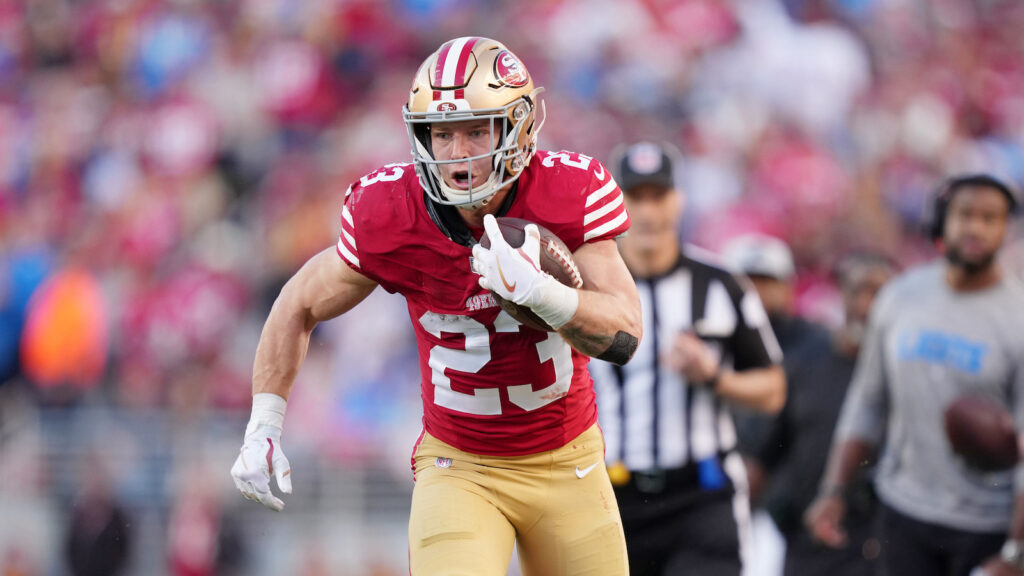
Will This Be The Christian McCaffrey Game?
If the Chiefs are going to go light, could this just be a Christian McCaffrey game? No matter Kansas City’s defensive personnel, their run defense is a glaring weakness.
In the regular season, it ranked 24th in EPA per play, 22nd in success rate, and 27th in run defense DVOA. They’ve been worse in the playoffs, though much of that is due to Buffalo Bills QB Josh Allen.
With the lighter personnel packages, the Chiefs have also played with light boxes and haven’t given much resistance to the run game off the line of scrimmage. Kansas City ranks 21st in yards allowed before contact per rush and 24th in yards allowed after contact per rush on running back carries. When the Chiefs play with a light box, they are 31st in yards allowed before contact.
While the Chiefs can get penetration along the defensive line against the pass, that isn’t the case when they play the run. Including the playoffs, Kansas City has 37 tackles for loss against the run. With extra games played, that only ranks 21st. On running back carries alone, those figures are 29th and 26th.
San Francisco doesn’t need much help creating space in the run game and when it does, McCaffrey has been difficult to bring down. Among running backs with at least 100 carries, McCaffrey ranks sixth in yards before contact per rush and fourth in yards after contact per rush. If the 49ers want, they can run McCaffrey all game and dare the Chiefs to stop him.
It’s also possible the Chiefs stay in those light boxes and dare the 49ers to run it all game. For as good as McCaffreyis on the ground, this offense is more dangerous when passing.
These two-high, light box looks would allow the 49ers to gain an advantage on the ground, but the Chiefs could be ready in the second level against the rushing attempts and the shorter passes they would be trying to force Purdy to throw.
Still, that could be a dangerous game to play because McCaffrey can take over a game if given the opportunity. That also extends to his receiving ability.
McCaffrey is one of the few running backs who can actually play receiver. His presence in that area changed how the 49ers have mixed and matched those personnel groupings and formations on offense.
The Chiefs ranked 22nd in DVOA against running back targets in the regular season, but they haven’t seen a back like McCaffrey. The closest they came was against the Bills and how Buffalo used James Cook.
That was mostly out of the backfield, but the Bills got Cook vertical, and he put up 104 yards on 10 targets over two games.
TBT.
— Dan Pizzuta (@DanPizzuta) January 18, 2024
To Week 14 but also the play of 2017/18 pic.twitter.com/SzdDy2CXtN
Stacking the box to stop the run might not help all that much either. With eight defenders in the box, the Chiefs still rank 18th in yards allowed before contact per rush and 30th in yards allowed after contact per rush on running back carries.
 When The Chiefs Have The Ball
When The Chiefs Have The Ball
Is Patrick Mahomes Back?
This was not a typical season for Mahomes. Last season, some were worried about Kansas City's offense, but it was still on top of just about every metric by a wide margin. For the most part, the worry in 2023 was real.
The offense ranked eighth in DVOA, and Mahomes was just 14th among quarterbacks in EPA per play. Of course, that lacks the context of the offense and the weight that was on Mahomes’s shoulders throughout the season.
But that was also part of the problem. Mahomes lifted the 2022 offense to be one of the league’s best, but the 2023 offense was mostly just getting by with Mahomes doing as much as he could.
That’s flipped in the playoffs. Mahomes is closer to his previous versions, even if some parts of his play are similar to the regular season.

Mahomes was excellent against a blitz-heavy Dolphins defense and was nearly flawless against the Bills. The first half against the Ravens was good enough to make up for a second half when Baltimore shut down the Kansas City offense.
The biggest shift has been the ability to avoid negative plays. That has not come at the expense of creating big plays. Mahomes has always been sacked on a low percentage of his pressures. In the regular season, he had the second-lowest rate of pressures turned into sacks at 11.2 percent. That’s dropped to 5.3 percent in the playoffs.
Mahomes hasn't thrown an interception in the playoffs and hasn’t really come close to doing so. However, San Francisco has the second-highest interception rate.
Another area where Mahomes has changed in the playoffs is on intermediate throws. With defenses still selling out to stop Mahomes from throwing deep, he’s had to adjust and find new ways to create explosive plays.
In the regular season, he threw between 11-19 air yards on 15.6 percent of his pass attempts. He completed 54.8 percent of those and averaged 0.30 EPA per play. In the playoffs, that rate has jumped to 17.5 percent but he’s completed 72.2 percent for 1.22 EPA per play. There’s more happening in the intermediate middle of the field.
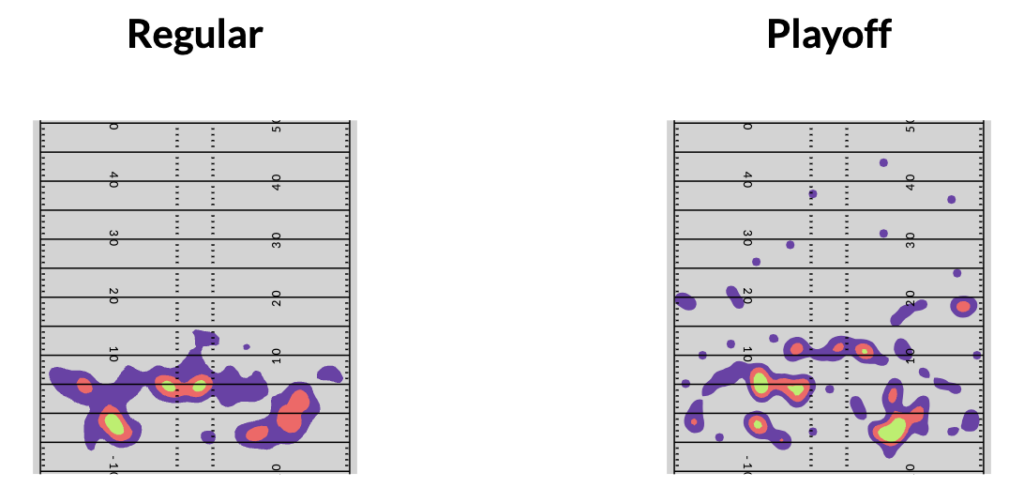
San Francisco is one of the best defenses against intermediate passes, finishing sixth in EPA per play. However, the Lions and Packers had success there in the playoffs.
>>READ: Pick Against Patrick Mahomes At Your Own Risk
Travis Kelce, Rashee Rice Have Clicked At The Right Time
A key to the Chiefs’ offense flipping a switch recently is the reliance on Travis Kelce and Rashee Rice. In the playoffs, those two have made up 57.2 percent of Kansas City targets.
When Mahomes has thrown to those two in the playoffs, he’s completed 82.7 percent of his passes for 9.3 yards per attempt and 0.78 EPA per play. When he’s thrown to anyone else, he’s completed 69.2 percent of his passes for 6.0 yards per attempt and -0.23 EPA per play.
Kelce flipped a switch of his own in the postseason after he didn’t have as big of an impact during the regular season. He was still efficient enough on a per-route basis (1.92 yards per route run) but played on just 71.7 of Kansas City’s dropbacks. He’s on the field more often in the playoffs (88.4 percent of dropbacks), and he’s averaging 2.65 yards per route run.
The Chiefs have changed how Kelce is used. He sees more snaps in-line as a traditional tight end than during the regular season.
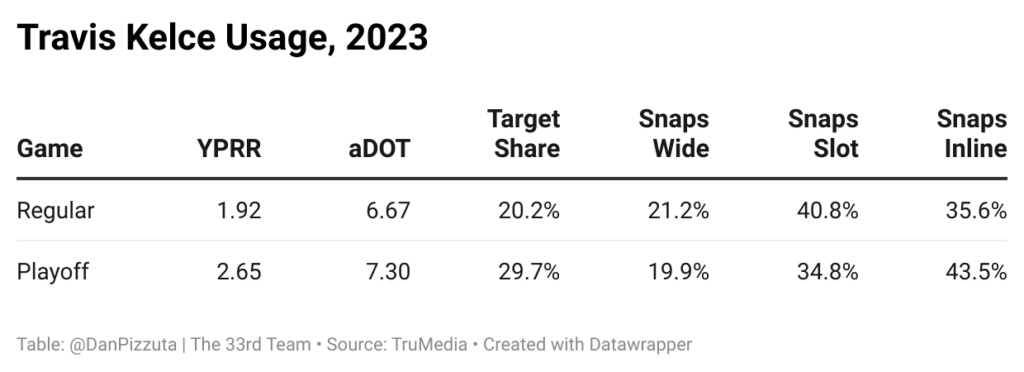
Despite lining up inside more often, just 14.8 percent of Kelce’s postseason targets have come from the tight end alignment — though that includes the 19-yard touchdown against Kyle Hamilton. However, it helped change the looks of the Kansas City offense. It’s enough to make Kelce more productive when he’s in the slot.
Kelce has averaged 3.04 yards per route run from the slot in the playoffs, as opposed to 1.66 in the regular season. His aDOT on those targets has also increased from 6.98 to 8.31.
The 49ers are one of the best teams at covering tight ends, ranking fourth in EPA per play and second in yards per target. There’s not much of a change when those targets come from the slot — eighth in EPA per play and fifth in yards per target.
If Kelce is going to be the focus for the San Francisco defense, then Kansas City could turn its focus to Rice. During the second half of the season, Rice has been the go-to and was out-targeting Kelce for stretches.
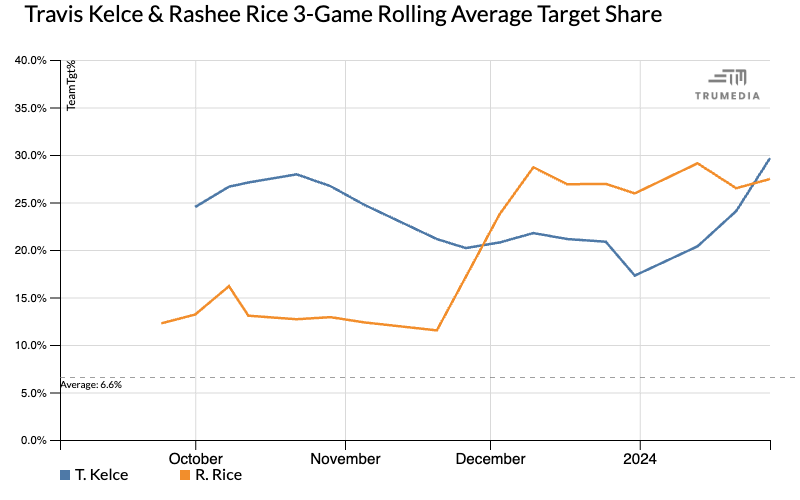
As Rice became more involved with the offense, his role blossomed as the underneath catch-and-run receiver. The Chiefs could create space in the middle of the field, and Rice could turn into a yards-after-the-catch monster.
Most of that was done on crossing routes. In the regular season, 15.6 percent of Rice’s routes were crossers, the 15th-highest rate among players with at least 350 routes.
Kansas City has basically doubled down on that in the postseason, with crossers making up 27.3 percent of Rice’s routes. He averaged 7.82 yards per route with nine receptions for 133 yards and a touchdown on crossers in the playoffs. He has more receptions of 20-plus yards on that route in the postseason (three) than he did in the regular season (one).
Similar to playing against tight ends, the 49ers have swallowed up crossing routes. Their linebackers usually drop to depth in the middle of the field, so there is not a lot of open space to catch and run. When facing crossers, the 49ers allowed just 5.7 yards after the catch per reception, the league's ninth-lowest rate.
>>READ: Where Does Kelce-Mahomes Combo Rank?
Spare A Quarter
The 49ers are one of the most static defenses in the league. They’ll often rush four — their 80.3 percent frequency leads the league — and do not often disguise coverage on the back end. What you see is, more often than not, what you get.
Where disguises come in is with the linebackers, who can play all over the field. You could see Fred Warner start a play in the A-gap pre-snap and end it 20 yards down the field covering a wide receiver, like he did against CeeDee Lamb in the playoffs last year.
Going back to the DAL-SF playoff game for a TBA project.
— Dan Pizzuta (@DanPizzuta) June 20, 2023
Had forgotten about this play. Fred Warner is just unreal. pic.twitter.com/NkSCkw7ukw
But even those looks have dropped a bit with the change from DeMeco Ryans to Steve Wilks at defensive coordinator. Those mugged-up pre-snap looks aren’t as effective when there isn’t much of a blitz threat.
That’s been especially true in the playoffs as the 49ers have only blitzed on 7.7 percent of dropbacks. With Nick Bosa and Chase Young on the edge, it would be fair to rely on a four-man rush, but it just hasn’t gotten home in the postseason.
While the pressure rate hasn’t dropped much from the regular season — down from 39.6 percent (seventh) to 37.2 percent (would rank 12th) — there have not been sacks to go with it. The 49ers have gone from a 7.2 percent sack rate in the regular season to 2.3 percent in the playoffs.
That’s a lot of pressure to put on the defensive line when the entire plan is built around winning with four. Mahomes is already hard enough to sack, and doing so with a static four-man rush can increase the degree of difficulty for the defense.
It’s also overlooked how well the Kansas City offensive line has pass blocked this season. Despite penalties before and after the snap, the Chiefs ranked first in ESPN’s pass block win rate for 2023.
If the pass rush can’t get home, that will stress the coverage that also doesn’t change much. Luckily, the 49ers are technically sound in their coverages and ranked sixth in EPA per play against the pass in the regular season.
While the 49ers don’t often disguise coverage, they don’t rely on the same coverage from down to down. San Francisco has played 45.9 percent of its snaps with middle-of-the-field open coverage and 50.5 percent with middle-of-the-field closed.
In the playoffs, that has shifted to 52.6 percent two-high coverages. That might be the strategy to run against Mahomes, whose efficiency has dropped against those looks.
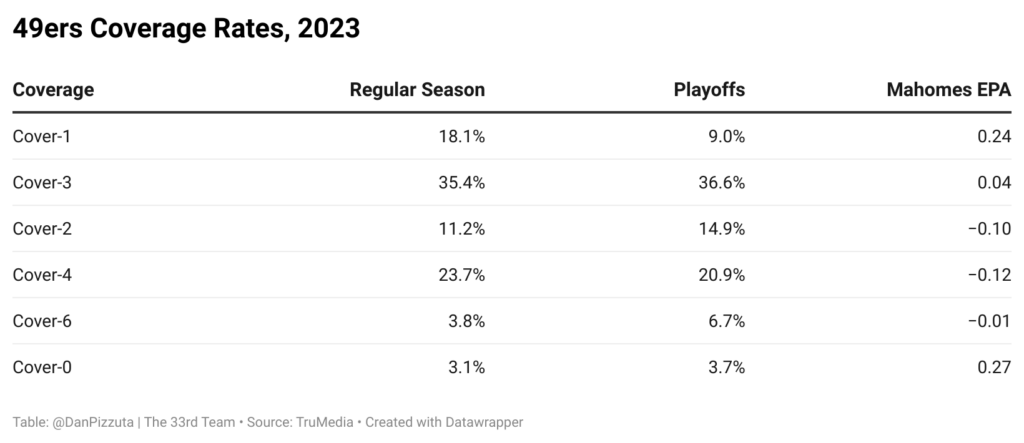
Mahomes has a lower aDOT and had a 3.1 percent interception rate against two-high coverages in the regular season.
49ers CB Charvarious Ward, who played for the Chiefs, has 18 of his 24 passes defended while playing more aggressively in single-high coverages. However, the 49ers could benefit from those two-high zone coverages and allow the defense to rely on passing routes off and tackle more than trying to aggressively play the ball.
Outside of Ward, that’s what has worked for San Francisco's pass defense. It ranks fourth among defenses in EPA per pass play in two-high and 17th in single-high.
The Power of 13 (Not Taylor's Version)
San Francisco won’t be alone in potentially manipulating the opposing defense with personnel. The Chiefs have leaned into the usage of tight ends, outside of just the playoff reinvigoration of Kelce.
During the regular season, the Chiefs ranked fourth in the rate of 12 (28.3 percent) and 13 personnel (7.4 percent). In the playoffs, the rate of 12 personnel has dropped to 26.2 percent, but the rate of 13 has risen to 19 percent.
On those regular season plays, the Chiefs went heavy in an effort to throw the ball. 51 percent of Kansas City’s 13 personnel plays were passes. They were efficient enough, averaging 0.03 EPA per play with a 58.3 percent success rate. The problem was they could not run the ball from those looks, with just an 18.9 percent success rate.
In the playoffs, the Chiefs have been even more efficient throwing the ball (0.48 EPA per play), but they’ve only passed on 24.3 percent of those plays. Even with the low pass rate, they’ve been used to sell the run or get big bodies out in space on screens.
They’ve run three successful screens to Kelce in the playoffs, including a 3-yard touchdown against the Bills.
Travis Kelce 13 personnel screens in the playoffs pic.twitter.com/137p8yp8y9
— Dan Pizzuta (@DanPizzuta) February 7, 2024
On top of the pass plays, Kansas City has found some success on the ground with a 44.8 percent success rate in the playoffs. The Chiefs bullied the Bills on the ground late in the game from these heavier looks, including a 29-yard run from Isiah Pacheco that gave Kansas City the ball inside the 5-yard line. That could have led to points, but Mecole Hardman fumbled out of the end zone on the next play.
Going heavy against the 49ers could be a risky proposition given the strength of their defense is the linebackers. San Francisco has only seen 23 snaps of 13 personnel this season, and they have matched with base on all 23. Opponents averaged 5.0 yards per play, and San Francisco had a 66.7 percent success rate on those plays.
Kansas City has not been as successful in 12 personnel but when it has, it’s been from throwing against nickel.
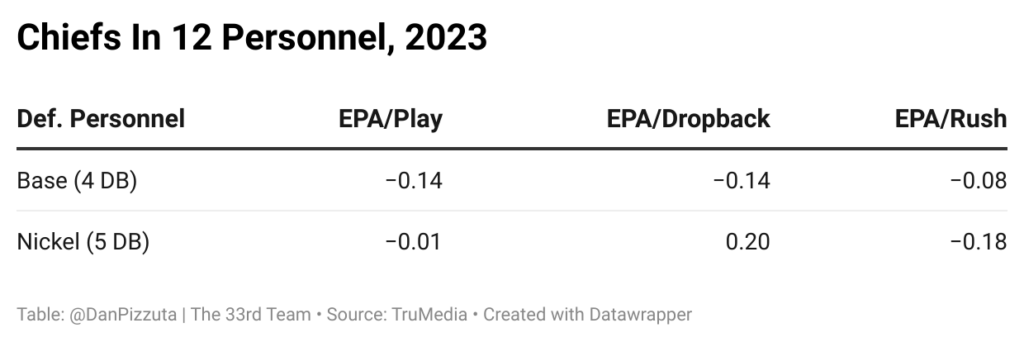
That probably won't be an option against San Francisco. The 49ers go 85 percent base when facing 12 personnel. We’ll likely see the Chiefs continue to ride in 13 personnel when they go heavy and to match with big bodies instead of hoping for a heavy vs. light mismatch in the passing game.
How To Run Against The 49ers
We highlighted the weakness of the Kansas City defense against the run, and it’s the same with the San Francisco defense. The 49ers are 28th in EPA per play against the run but have been better in the playoffs, holding the Packers and Lions to modest games on the ground.
Still, this is a defense that can be taken advantage of in the running game. That’s in part because of the aggressive nature of its four-man front.
This play turns into a 15-yard gain for David Montgomery from 12 personnel against San Francisco’s base defense. Because of the width of the defensive line, especially Bosa on the edge, the Lions can quickly get all of their linemen to the second level. While the run is to the opposite side of Bosa, he’s unblocked, and his quick first step into the backfield works against him as he charges into the backfield.
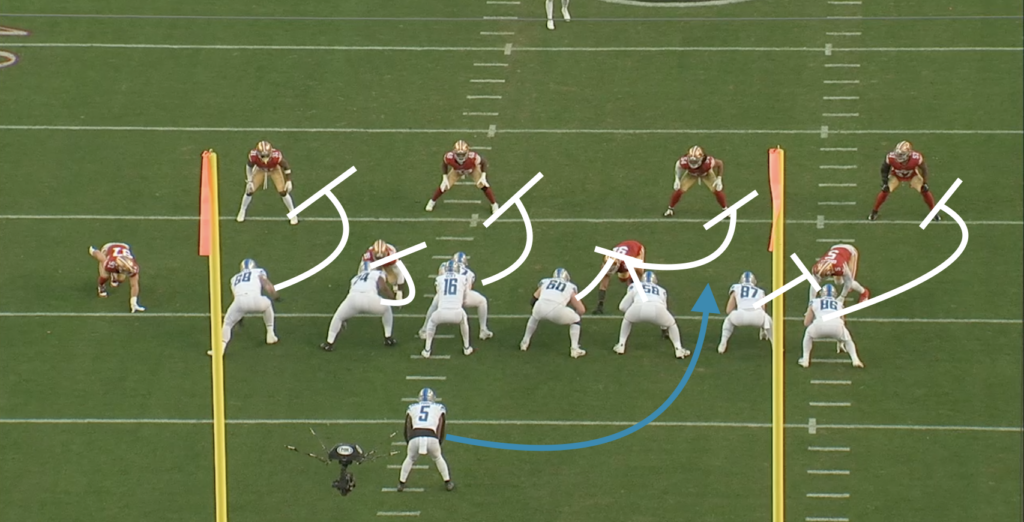
Another way the aggressiveness can be used against the 49ers is with pin-pull concepts — a receiver pins the edge rusher toward the formation while offensive linemen pull around them to the second level. The Packers used this a bunch against the 49ers in the divisional round, getting a body in front of Bosa and getting the back to the outside.
— Dan Pizzuta (@DanPizzuta) February 7, 2024
No team saw pin-pull runs against them at a higher rate than the 49ers this season. Few teams were worse on runs to the outside. Per FTN, San Francisco ranked 30th in adjusted line yards to the left end and 20th to the right end. Bosa plays most of his snaps on the left side.
The Chiefs aren't a heavy pin-pull team, but they have those runs in their arsenal. Instead, Kansas City is stronger running up the middle. It is more of a power team, which includes a puller, but targets the middle of the defense. That’s an area where San Francisco is stronger.
It might not matter which type of runs the Chiefs use if the 49ers can’t bring Pacheco down. Even while the San Francisco run defense is better overall in the postseason, the Niners have allowed 3.81 yards after contact per rush. In the regular season, their 2.84 yards after contact per rush ranked 19th.
Pacheco doesn’t have eye-popping yards-after-contact numbers, partly because he sees initial contact earlier than most running backs, but he’s a back who runs angry and rarely goes down on first contact.
We’ll see if that translates to passes to the running back. Mahomes has mostly eliminated those in the playoffs because the rate of throws to tight ends has increased.
San Francisco was eighth in DVOA against running back passes, though the 49ers were 24th in EPA per play against running back screens in the regular season.
However, Pacheco is not the offense's main back for screens. Clyde Edwards-Helaire and Jerrick McKinnon are more involved in those concepts. McKinnon is unlikely to practice this week, per Andy Reid, so this could be an area where Pacheco plays a bigger role.


